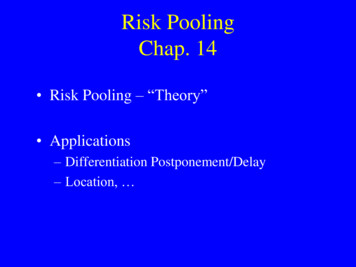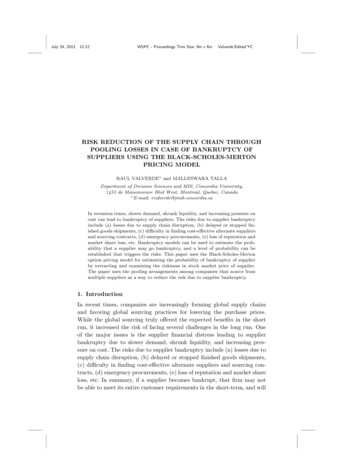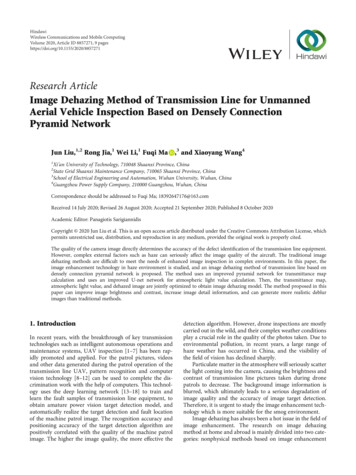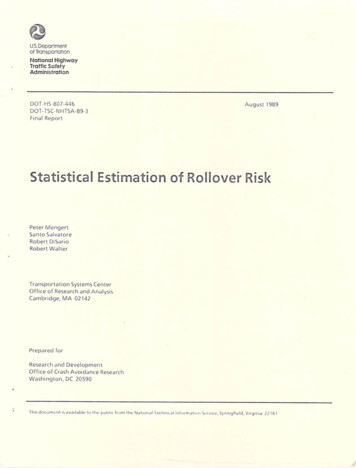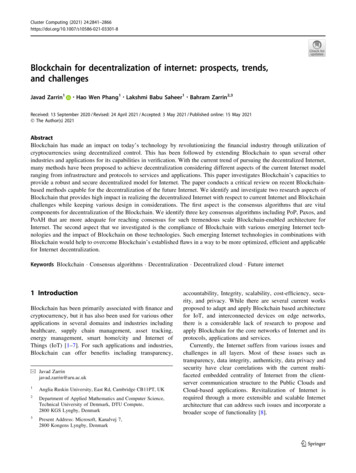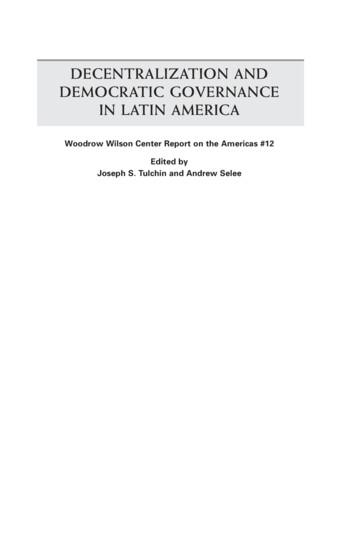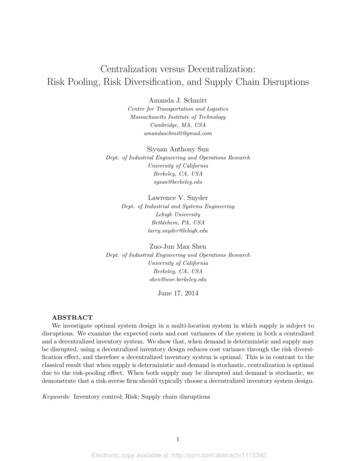
Transcription
Centralization versus Decentralization:Risk Pooling, Risk Diversification, and Supply Chain DisruptionsAmanda J. SchmittCenter for Transportation and LogisticsMassachusetts Institute of TechnologyCambridge, MA, USAamandaschmitt@gmail.comSiyuan Anthony SunDept. of Industrial Engineering and Operations ResearchUniversity of CaliforniaBerkeley, CA, USAsysun@berkeley.eduLawrence V. SnyderDept. of Industrial and Systems EngineeringLehigh UniversityBethlehem, PA, USAlarry.snyder@lehigh.eduZuo-Jun Max ShenDept. of Industrial Engineering and Operations ResearchUniversity of CaliforniaBerkeley, CA, USAshen@ieor.berkeley.eduJune 17, 2014ABSTRACTWe investigate optimal system design in a multi-location system in which supply is subject todisruptions. We examine the expected costs and cost variances of the system in both a centralizedand a decentralized inventory system. We show that, when demand is deterministic and supply maybe disrupted, using a decentralized inventory design reduces cost variance through the risk diversification effect, and therefore a decentralized inventory system is optimal. This is in contrast to theclassical result that when supply is deterministic and demand is stochastic, centralization is optimaldue to the risk-pooling effect. When both supply may be disrupted and demand is stochastic, wedemonstrate that a risk-averse firm should typically choose a decentralized inventory system design.Keywords: Inventory control; Risk; Supply chain disruptions1Electronic copy available at: http://ssrn.com/abstract 1115392
1IntroductionAs supply chains expand globally, supply risk increases. Classical inventory models have generallyfocused on demand uncertainty and established best practices to mitigate demand risk. However,supply risk can have very different impacts on the optimal inventory management policies and caneven reverse what is known about best practices for system design.In this paper, we focus on the impact of supply uncertainty on a multi-location system andcompare two policies: centralization (stocking inventory only at a central warehouse) and decentralization (stocking inventory at multiple warehouses). Our analysis is a special case of OneWarehouse Multiple-Retailer (OWMR) system analysis; while most research on the OWMR modelallows inventory to be held at both echelons, we allow inventory to be held at only one echelon inorder to consider two opposing effects that can occur: risk pooling and risk diversification. Therisk pooling effect occurs when inventory is held at a central location, which allows the demandvariance at each retailer to be combined, resulting in a lower expected cost [Eppen, 1979]. The riskdiversification effect occurs when inventory is held at a decentralized set of locations, which allowsthe impact of each disruption to be reduced, resulting in a lower cost variance [Snyder and Shen,2006]. Whereas the risk-pooling effect reduces the expected cost but (as we prove) not the costvariance, the risk-diversification effect reduces the variance of cost but not the expected cost.We prove that the risk diversification effect occurs in systems with supply disruptions. We alsoconsider systems with both supply and demand uncertainty, in which both risk pooling and riskdiversification have some impact, and numerically examine the tradeoff between the two. The riskmitigated through risk diversification is disruption risk or supply risk, whereas the risk mitigatedthrough risk pooling is demand risk. We employ a risk-averse objective to minimize both risk sourcesand determine which effect dominates the system and drives the choice for optimal inventory systemdesign.Specifically, comparing centralized and decentralized inventory policies, we contribute the following: The exact relationship between optimal costs and inventory levels when demand is deterministic and supply is subject to disruption The exact relationship between optimal cost variances when:– demand is deterministic and supply is subject to disruption– demand is stochastic and supply is deterministic Formulations of the expected cost and cost variance when demand is stochastic and supplyis subject to disruption2Electronic copy available at: http://ssrn.com/abstract 1115392
Evidence that decentralization is usually optimal under risk-averse objectivesThe remainder of the paper is organized as follows. In Section 2 we review the relevant literature. In Section 3 we analyze the risk-diversification effect in a multi-location system withdeterministic demand and disrupted supply. We consider stochastic demand and deterministicsupply in Section 4. In Section 5 we consider both demand uncertainty and supply disruption andagain compare inventory strategies using a risk-averse objective to choose the optimal inventorydesign. We summarize our conclusions in Section 6. Proofs for all propositions and theorems aregiven in the Appendix.2Literature ReviewSupply chain risk management has been widely studied ever since the concept of uncertainty wasintroduced into inventory theory. Uncertainty in supply chains is usually classified as either demanduncertainty or supply uncertainty. A simple model with demand uncertainty is the newsvendorproblem, which determines the optimal order quantity or inventory level to minimizes the expectedcost under stochastic demand in a single period for a single location. Eppen [1979] extends thenewsvendor problem to a multiple-location model and shows that under demand uncertainty, acentralized inventory strategy provides risk-pooling benefits and reduces expected cost versus adecentralized strategy. Demand pooling is now a familiar idea in operations management andserves as a major instrument to protect against demand uncertainty. Corbett and Rajaram [2006]generalize Eppen’s work to the case of non-normal, dependent demand and show that the magnitudeof the risk-pooling effect increases when the demands are less positively dependent. Berman et al.[2011] analyze the benefit of inventory pooling in a multi-location newsvendor framework and showthat the absolute benefit of risk pooling increases with demand variability.There are several ways to implement demand pooling, including transshipments, postponement,and product substitution. Yang and Schrage [2009] explore the conditions that cause risk poolingto increase inventory under the setting of product substitution. Paterson et al. [2011] review theliterature on transshipments as an analogue of inventory pooling. Alptekinoglu et al. [2013] proposea model of inventory pooling to meet differentiated service levels for multiple customers. In general,these forms of pooling leverage centralization so as to diminish the impact of demand uncertaintyon supply chain performance, which can be thought of as a generalization of the risk-pooling effectstudied by Eppen [1979] and by this paper. On the other hand, our work deviates from this streamof literature by considering supply uncertainty as well.3
Supply uncertainty has been considered in several settings, including newsvendor [e.g., Dadaet al., 2007, Tomlin, 2009] and EOQ [e.g., Berk and Arreola-Risa, 1994, Parlar and Berkin, 1991,Snyder, 2014] systems. The two most commonly considered forms of supply uncertainty are supplydisruptions (in which supply is halted entirely for a stochastic amount of time) and yield uncertainty(in which the quantity delivered from the supplier is random). Chopra et al. [2007] and Schmittand Snyder [2012] consider systems that have both supply disruptions and yield uncertainty. Theliterature on single-echelon (newsvendor) systems with both of these types of supply uncertainty isextensive, and we omit an exhaustive review here. The reader is referred to Atan and Snyder [2012]and Snyder et al. [2010] for reviews of the literature on inventory models with supply disruptionsand Yano and Lee [1995] for a discussion of the literature on single-echelon systems with yielduncertainty. Multi-period models with stochastic demand and supply have been considered bySchmitt et al. [2010] and Tomlin [2006], among others, and we rely on several of their results inthis paper. Schmitt et al. develop a closed-form approximate solution for the optimal base-stocklevel in the face of disruptions and stochastic demand. Tomlin investigates multiple strategies forcoping with disruptions, including acceptance (doing nothing proactively), sourcing (using multiplesuppliers), and inventory policies. These papers provide a foundation for our analysis, but ourapplication to the OWMR model provides new insights on the impact of supply disruptions incomplex systems.Regarding the management of supply risk, Aydin et al. [2012] point out that decentralization, acommonly approach to mitigate supply risk, creates a misalignment of incentives between suppliersand buyers, competition among suppliers, competition among buyers, and asymmetric informationamong the supply chain parties, while Ellis et al. [2011] discusses the implementation of supplydisruption risk research. Interested readers are referred to Babich et al. [2007], Yang et al. [2009],Tang and Kouvelis [2011] and Yang et al. [2012] for a closer discussion of competition versusdiversification. Decentralization also provides flexibility for decision makers at the strategic level.For example, Yu et al. [2009] consides the effects of supply disruptions on the decision of whetherto single- or dual-source. Wang et al. [2010] compare dual sourcing and process improvement tomitigate supply risk. Sawik [2011], Sawik [2013] and Qi [2013] discuss supplier selection when thesupply is subject to disruptions.Decentralization may be deployed not only occur among suppliers, but also in the inventorysystems themselves. Snyder and Shen [2006] use simulation to study multiple complex inventorysystems, including the OWMR system with supply uncertainty with inventory at a single echelon.4
Their simulation results show that, under supply disruptions, expected costs are equal for centralized and decentralized systems, but the variance of the cost is higher in centralized systems. Theycall this the risk-diversification effect and suggest that it occurs because a disruption in a centralized system affects every retailer and causes more drastic cost variability. They conclude that riskdiversification increases the appeal of inventory decentralization in a system with disruptions. Inthe context of multi-location inventory management, decentralization or diversification is leveragedto achieve lower cost variance instead of the expected cost, as in, e.g., Schmitt and Snyder [2012]and Tomlin [2006].In this paper we consider supply and demand uncertainty in a multiple-demand-point systemwhere inventory may be held at a centralized warehouse to mitigate the demand risk or at multiplewarehouses to mitigate the supply risk. We assume that inventory may be held at only a singleechelon in order to draw clear conclusions regarding centralization versus decentralization. Weexplore the implications of the risk diversification effect by developing an analytical model forthe expected cost and cost variance of a multi-location system subject to supply uncertainty. Weanalytically prove the presence of risk diversification in this system, discuss its impact, and examinethe system under uncertainty in both supply and demand. When demand is deterministic andsupply is subject to disruptions, we determine the optimal inventory levels and costs. For thatcase and the case in which demand is stochastic and supply is deterministic, we quantify thecost variance. We combine supply disruptions and stochastic demand in a subsequent model andformulate the expected costs and cost variances. To consider the effect of cost variances in thedecision making process, we adopt a risk-averse objective to incorporate the cost variance with theexpected cost at the same time.In the latter part of this paper, we consider risk-averse objectives for inventory optimization.Risk-aversion, a topic which is gaining momentum in the operations literature, has been consideredin newsvendor models to mitigate demand uncertainty. For example, Eeckhoudt et al. [1995]show that order quantities decrease with increasing risk-aversion. Van Meighem [2007] considersresource diversification in newsvendor models with risk-averse objectives, advocating diversifyingresource availability to protect against risk. Tomlin and Wang [2005] consider a single-periodnewsvendor setting with supply disruptions; they model loss-averse and conditional value-at-risk(CVaR) objectives when deciding between single- and dual-sourcing and between dedicated andflexible resource availability. Chen et al. [2007] consider multi-period inventory models with riskaversion, modeling both replenishment and pricing decisions. Tomlin [2006] also considers a multi-5
period setting and employs a mean–variance approach to consider risk in a two-supplier system inwhich one supplier is subject to disruptions and the other is perfectly reliable but more expensive.We show that under a risk-averse objective function, the benefits of risk diversification typicallysurpass those of risk pooling and therefore decentralization is the optimal network configuration.3Risk Diversification Effect with Supply DisruptionsIn this section we examine the impact of supply disruptions on both the centralized and the decentralized multi-location system. Before we present the models, we describe our assumptions andnotation.3.1Assumptions and NotationWe consider a two-echelon inventory system where demand occurs according to the same distribution across multiple locations. We assume all locations follow a base-stock policy, and we comparepolicies for stocking inventory at the central warehouse only (centralized system) or at multiplewarehouses (decentralized system). We assume the fixed ordering costs are zero for the all thefollowing analysis. This enables us to place orders in every period regardless of any fixed order costfor a multi-period system. This is not unreasonable in internal distribution settings. We discusswhat impact this might have in our conclusions. We also assume zero lead times since deterministiclead times would not impact optimal base-stock levels or order quantities, but would simply requirethat orders be placed exactly the lead time quantity in advance.A holding cost of h per unit per period is incurred at the warehouse in the centralized systemor at each of the warehouses in the decentralized system. The holding costs are evaluated after thedemands are realized. Unmet demands are backordered, and a stockout penalty of p per unit perperiod is incurred in both systems.The parameters, decision variables (base-stock levels at each location), and performance mea is defined as the optimalsures for the system are summarized in Table 1. Note that since SDbase-stock level for an individual warehouse in the decentralized system, the total inventory for .that system is nSDIn both the centralized and decentralized systems, disruptions occur randomly at the inventorylocation(s); that is, disruptions occur at the central warehouse in the centralized system or at anyof the multiple warehouses in the decentralized system. Disruptions occur independently at alllocations in the system. Examples of disruptions of this nature could include disruption of an6
NotationnphS SDSC E[C]E[CD ]E[CC ]V [C]V [CD ]V [CC ]Table 1: NotationDefinitionnumber of demand sets or locations; number of decentralized warehousespenalty cost per period at each facilityholding cost per period at each facilityoptimal base-stock level for an individual facilityoptimal base-stock level for each warehouse in the decentralized systemoptimal base-stock level for the warehouse in the centralized systemexpected cost for an individual facilityexpected cost for the decentralized systemexpected cost for the centralized systemvariance of the cost for an individual facilityvariance of the cost for the decentralized systemvariance of the cost for the centralized systemupstream supplier, failure of inbound transportation capabilities (e.g., a snowstorm or flood thatshuts down rail or major roadways), transportation labor issues (e.g., a port strike), shipmentquality issues (e.g., a bacterial contamination), or other major issues that interrupt material flowto a single location. In our model, there is no back-up source of material available (i.e., no crossshipments or alternate sources) when a disruption occurs at a facility. If a disruption occurs atthe central warehouse, then all downstream locations feel any resulting shortage equally. In bothsystems, disruptions “pause” the flow of supply to the disrupted stage, but any inventory at thatstage may still be used during the disruption; therefore, disruptions affect a stage’s supply-receivingfunction but not its demand-receiving function.We model the disruptions as a random process governed by the pmf πi and cdf F (i), where iis the number of consecutive periods during which a given stage has been disrupted, as is typicalin the supply disruption literature [e.g., Hopp and Liu, 2006, Tomlin, 2006]. Therefore πi is theprobability that a given stage has been disrupted for precisely i periods (i 0) and F (i) is theprobability that it has been disrupted for i periods or fewer. Disruptions may be governed by aMarkov chain or a more general process. The locations have identical and independent disruptionprocesses that are stationary over time. After modeling the disruptions using this random process,we can evaluate the expected costs and cost variances for both the centralized and decentralizedmulti-location systems. We use an additional subscript s to denote the disrupted-supply modeldiscussed in this section.7
3.2Mean and Variance of Optimal CostFor a base-stock inventory policy at a single warehouse, the costs in a given period depend on thestate of the system, defined as the number of consecutive periods for which it has been disrupted.The expected cost and optimal base-stock level for such a system are given by [see, e.g., Snyderand Shen, 2011]:sE [C] Xπi [h(S s (i 1)d) p((i 1)d S s ) ](1)i 0S s jd, where j is the smallest integer such that F (j 1) pp h(2)Schmitt et al. [2010] discuss these results, demonstrating that the optimal base-stock level is anincreasing step function of the newsvendor fractile and the disruption probability. As the cost ofdisruptions increases, the optimal solution increases by discrete jumps to the next whole period’sworth of demand.Incorporating these results in our analysis of the centralized and decentralized multi-locationsystems, we present the relationships between the inventory levels, expected costs, and cost variances for the various systems in the following theorem.Theorem 1 In the systems subject to supply disruptions, the optimal base-stock levels and performance measures in the centralized, decentralized, and single-facility setting are related as follows:s nS s 1. SCs nSD ] nE s [C ]2. E s [CC ] E s [CD ] n2 V s [C ]3. V s [CC ] nV s [CDProof : See Appendix, Section A.2.The theorem states that the total system inventory levels and expected costs are equal in thecentralized and decentralized systems, but the cost variance is n times greater for the centralizedsystem, suggesting that the decentralized system is preferred for a risk-averse decision maker.The reduction in the cost variance for a decentralized system while incurring the same level ofthe expected cost as in the centralized system is called the risk diversification effect. The riskdiversification effects occurs when the supply is subject to disruption and demand is deterministic.The intuition behind Theorem 1, i.e., the risk diversification effect, is as follows. Because thecentralized system is just an aggregation of the demands from the decentralized system with the8
identical random disruption process, the total base-stock levels at optimality should be the samefor the two systems. That is to say, the total inventory devoted to each of the n sets of customers isthe same in both systems. Therefore each customer set faces the same number of stockout periods(effects of disruptions) on average in both systems due to the independence and homogeneity ofthe supply disruption processes. By defining the service level as the number of stockout periods onaverage, commonly known as the type-1 service level, another way to say the above is that identicaldisruption processes in both systems cause the customer set to experience the same service level.We state this formally in the following Corollary.Corollary 2 In the multi-location system subject to supply disruptions, if base-stock levels are setoptimally, the distribution of consecutive periods for which a given warehouse is stocked out isidentical for the centralized and decentralized systems.This same stockout distribution causes the expected holding and stockout costs to be the samein both systems. However, disruptions are less frequent and more severe in the centralized systemthan in the decentralized system due to the independence of the disruptions in the decentralizedsystem and the aggregation of the demands in the centralized system. Therefore the centralizedsystem incurs a greater cost variance.The relationships presented in Theorem 1 demonstrate the risk diversification effect in systemsin which the supply is subject to disruption. If demand is deterministic, the risk from uncertainsupply is mitigated in the decentralized system, as the lower variance for that system demonstrates.Moreover, expected costs for the centralized and decentralized systems are equal. Snyder and Shen[2006] demonstrate a similar result using simulation, though their model differs slightly from oursin that they assume that inventory at a given stage may not be used when that stage is disrupted.However, the risk pooling effect, which favors a centralized system, is observed when demand isstochastic and supply is deterministic. We present these results in the next section.4Risk Pooling Effect with Stochastic DemandIn this section, we present the risk pooling effect when the demand is stochastic but supply is deterministic. We consider the classical model discussed by Eppen [1979]. Following Eppen, considertwo alternative system configurations: the centralized system and the decentralized system. Inboth systems, the supply is deterministic while the demand is stochastic. The demand is normallydistributed with the same mean µ and variance σ 2 at each of the decentralized warehouses. There9
fore, the demand at the central warehouse in the centralized system has mean nµ and variance nσ 2 .We employ a superscript d to denote this model with stochastic demand. Optimal base-stock levelsare the major concerns for both the centralized system and the decentralized system. We thereforereview the results concerning the expected costs and their corresponding optimal base-stock levelspresented by Eppen [1979]. Since we are interested in not only the average performance of thesystems but also the stability of the systems, we evaluate the cost variances of the systems atoptimality in Section 4.2. To the best of our knowledge, ours is the first study to consider the costvariance at optimality in these systems.4.1Expected CostThe expected cost and optimal base-stock level for a single warehouse subject to stochastic demandfollowing normal distribution N (µ, σ 2 ) are well known as: d dd1 S µE [C] h(S µ) σ(p h)Φ(3)σ pS d µ σΦ 1(4)p hR where Φ1 (x) x (v x)ϕ(v)dv is the standard normal loss function. The expected cost andoptimal base-stock level here can be directly applied to a single warehouse in the decentralized2 ), wheresystem. For the centralized system, the demand follows a normal distribution N (nµ, σC2 nσ 2 . Therefore, for the centralized system,σC d dd1 SC nµE [CC ] h(SC nµ) σC (p h)ΦσC pd 1SC nµ σC Φp h(5)(6)Since the decentralized system functions as n single-warehouse systems, E d [CD ] nE d [C] andd S d . We have the following theorem:SDTheorem 3 (Eppen, 1979) The optimal expected costs and inventory levels for the centralizedand decentralized multi-location systems subject to stochastic demand are as follows: ] E d [CDd nSD SCd nE d [CC ] (n (7)n)σΦ 1 pp h (8)10
Proof: Given by Eppen [1979].This theorem exhibits the benefits of centralization: by serving the warehouses’ demand froma centralized inventory site, we pool the risk from demand uncertainty. As a result, the optimal expected cost for the centralized system is n times smaller for the decentralized system, and lessinventory is required. Next, we evaluate the cost variance for both systems at optimality.4.2Cost VarianceThe following theorem presents the relationship between the cost variances for the two systems.Theorem 4 At optimality, the cost variance for the centralized and decentralized multi-locationsystems subject to stochastic demand are equal: V d [CC ] V d [CD](9)Proof: See Appendix, Section A.3.This theorem claims that centralization reduces the expected cost of the system while notaffecting the cost variance compared to a decentralized multi-location system, which is referredto as the risk pooling effect. This suggests that centralization is optimal under the presence ofstochastic demand and deterministic supply.We therefore obtain the following conclusions so far. Under stochastic demand and deterministicsupply, centralization is optimal due to the risk pooling effect, which affects the expected cost onlyand has no impact on cost variance. In contrast, under supply disruptions and deterministic supply,decentralization is optimal due to the risk diversification effect, which affects the cost variance onlyand has no impact on the expected cost. A natural question is, when both demand uncertaintyand disruptions are present, which system is optimal, i.e., which prevails: risk pooling or riskdiversification? We address this question in the next section.5System with Supply Disruptions and Stochastic DemandIn this section we compare the cost means and variances for centralized and decentralized multilocation systems in which each warehouse is subject to stochastic demand and the whole system issubject to disrupted supply. We assume that when supply is not disrupted, the yield is deterministic.We use a superscript b to denote this model since both supply and demand are stochastic. Weformulate the expected costs and cost variances in Sections 5.1 and 5.2, respectively. We perform11
numerical analysis to compare the performance of the two systems in Section 5.3. Finally, in Section5.4, we introduce a mean–variance objective that allows us to choose optimally between the twosystems when risk aversion is accounted for. We summarize our findings in Section 5.5.5.1Expected CostsAt a single warehouse, a single period’s demand is denoted D and is distributed as N (µ, σ 2 ), whilethe total demand in i periods is distributed as N (iµ, iσ 2 ). The cost for a single warehouse subjectto normally distributed demand and disrupted supply is given by Schmitt et al. [2010] as:!Z Z Sb XE b [C] πi 1 h(id S b )fi (id)dd(S b id)fi (id)dd p i 1 XSb b b1 S iµ πi 1 h(S iµ) σ i(p h)Φσ ii 1(10)Schmitt et al. [2010] prove that E b [C] is convex and argue that the optimal base-stock level cannot be found in closed form because Φ S iµappears in the first-order condition for i 0, 1, . . . , .σ iUsing (10), we derive the expected costs for the two systems in the following Proposition.Proposition 5 When demand is normally distributed at the warehouses and supply is subject todisruptions, the expected costs for the centralized and decentralized multi-location systems are: b X 1 SD iµbb E [CD ] nπi 1 h(SD iµ) σ i(p h)Φ(11)σ ii 1 b X 1 SC inµbb (12)E [CC ] πi 1 h(SC inµ) σ in(p h)Φσ ini 1Proof: See Appendix, Section A.4.b S b . For the centralized system, we have confirmedClearly, for the decentralized system, SDnumerically that SCb 6 nS b in general, as in the deterministic-demand model in Section 3. Unlikethat model, SCb is neither consistently greater than nor consistently less than nS b when demandis stochastic. As a result, the expected cost for the centralized system at optimality is not consistently less than in the decentralized system as suggested by the risk pooling effect. However,we demonstrate numerically in Section 5.3 that the centralized system has a lower expected costthan the decentralized system in most of the instances we test, which confirms that, when demandis stochastic, the risk pooling effect usually holds (i.e., the centralized system has lower expectedcost), even when supply is subject to disruption.12
5.2Cost Varianceb in the decentralized system andWe present the cost variance for arbitrary base-stock levels (SDSCb in the centralized system, respectively) in the following Proposition.Proposition 6 When demand is normally distributed at the warehouses and supply is subject todisruptions, the cost variances for the decentralized and centralized multi-location systems are:" b !Xb2 b 2b22 22 222 SD iµ V [CD ] nπi 1 (h SD 2SD iµ iσ i µ ) 2iσ (p h )Φσii 1 b !2 X SD iµb iµ) σ i(p h)Φ1πi 1 h(SD(13)σii 1 b ! Xb2b2b22 2 22 222 SC niµ V [CC ] πi 1 h (SC 2SC niµ niσ n i µ ) 2niσ (p h )Φ σnii 1 b !2 X b1 SC niµ πi 1 h(SC niµ) σ ni(p h)Φ,(14)σnii 1where Φ1 (·) is the standard normal loss function and Φ2 (·) is the standard normal second-order lossfunction.Proof: See Appendix, Section A.5. ] (as the riskWe have confirmed numerically that it is not always true that V b [CC ] V b [CDdiversification effect would suggest). However, we demonstrate numerically in Section 5.3 that thisinequality holds for most of the instances we tested. Thus, when supply may be disrupted, therisk d
due to the risk-pooling e ect. When both supply may be disrupted and demand is stochastic, we demonstrate that a risk-averse rm should typically choose a decentralized inventory system design. Keywords: Inventory control; Risk; Supply chain disruptions 1
